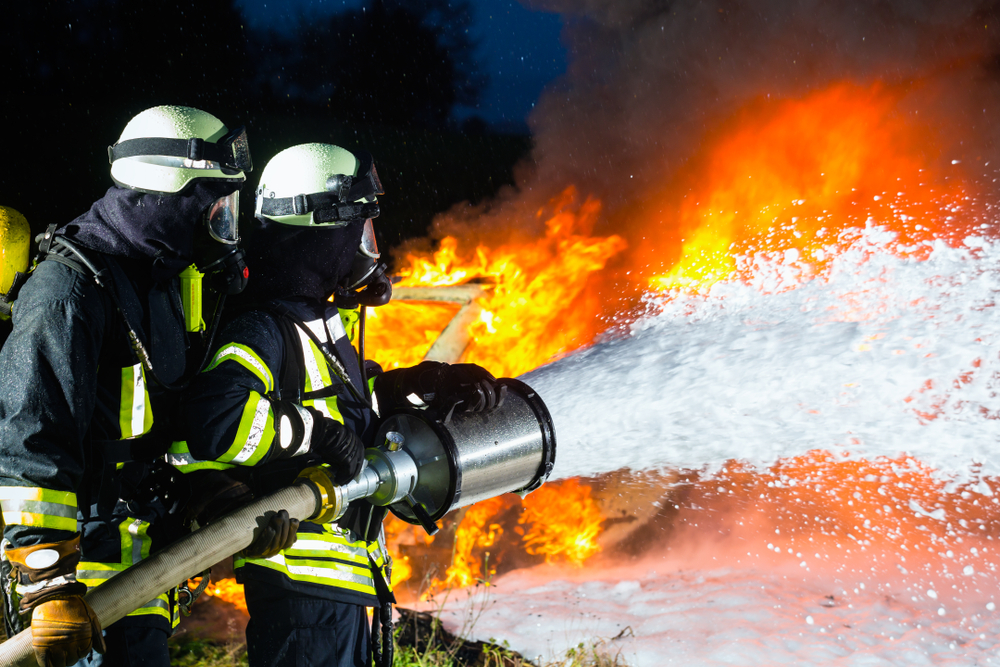Hundreds of firefighters have come forward in recent years over the dangers of certain chemicals found in aqueous film-forming foam (AFFF) or firefighting foam. According to court filings in 2021, firefighters have started the class action lawsuit over chemicals in AFFF. The firefighters claim that the chemicals in the mixture are linked to cancer, high blood pressure, issues during pregnancy, birth complications, and more.
While many of the lawsuits filed were individual claims by firefighters or the families of firefighters, a man in Texas filed the first class-action lawsuit over harmful chemicals found in AFFF and in the facility that the foam was being produced. The complainant claimed that these chemicals could lead to cancer if overused, mishandled, or used frequently without protection.
If you or a loved one was impacted by AFFF chemicals, read on. We’re going to take you through everything you need to know about the foam, the class action case based on it, and what to do if you’ve been impacted.
- Status of the Case
- What Is AFFF?
- What Should I Do if I Have Been Affected by Firefighter Foam?
- How to Know if I Qualify to Be Part of a Firefighter Foam Lawsuit?
- How Does the Firefighter Foam Lawsuit Work?
- How Long Does It Take To Settle a Firefighter Foam Lawsuit?
- What Is the Statute of Limitations on a Firefighter Foam lawsuit?
- How Much Can You Get From a Firefighter Foam Lawsuit?
- How Long Does It Take To Get Your Money After You Settle a Lawsuit?
- Get Help for an AFFF Class Action Today!
Status of the Case
The firefighter foam class action lawsuit began in January of 2021. The class action began when a Texas man filed a lawsuit based on polyfluoroalkyl substances (PFAS) found within AFFF and its production facility. Aside from this case, there have been over 800 claims in recent years against the company DuPont, which is a primary manufacturer of AFFF.
While the suit started small, it quickly grew. As of February of 2021, there are over 1,000 pending claims in multidistrict litigation taking place in South Carolina. According to reports, this is a massive increase over the 800 claims made in December of 2020.
Most of the cases have been filed based on the risks and hazards that AFFF has put firefighters through (active or retired). For example, many reports claim that the foam can cause kidney cancer, bladder cancer, testicular cancer, kidney cysts, tumors, testicular pain, and many other health issues.
The Companies Involved
The AFFF class action lawsuit has targeted three major companies that produce and sell the foam. These companies include 3M, DuPont, and Chemours. The lawsuits against each company are similar, and the claims by firefighters are based on the companies knowing that the AFFF could lead to harmful side effects. For example, firefighters and health officials claim that the companies know AFFF could lead to a buildup in the body.
While the companies are under attack from individuals and families, states have also taken matters into their own hands. States have started to sue 3M for PFAS contamination. States have also sued companies like 3M over the cost of cleaning up AFFF, which was multitudes higher than what was previously thought.
Moreover, companies like DuPont and Chemours have been in hot water in the past. For example, in 2017, DuPont and Chermours both settled a lawsuit for environmental pollution involving perfluorooctanic acid (PFOA). The pollution occurred at the Washington Works Plant, and both companies denied wrongdoing. DuPont and Chemours had to pay over $670,000,000 to over 3,500 people.
DuPont was also the target of another recent case. In March of 2020, the company had to settle a case for $50 million. The money was paid to a man that said PFOA contaminated his drinking water and led to testicular cancer. Overall, these companies are notorious for creating dangerous chemical compounds that lead to cancer and other injuries.
What Is AFFF?
AFFF is the abbreviation for aqueous film-forming foam. The foam is designed for firefighters to extinguish fires without needing egregious amounts of water. That said, the mixture was made to handle liquid-based fires that water alone is unable to extinguish.
While water is the primary method of putting out fires, AFFF became popular over the years because of its versatility. This began in the 1960s when firefighters used it to control massive fires that did not react to conventional means like water –even the military began using the foam in the 1970s.
AFFF was and is useful, but the main problem is that it contains “forever chemicals.” These are chemicals that don’t break down naturally. So, when they get absorbed by your body, they have nowhere to go. This leads to buildups and other dangers.
Dangers of AFFF
AFFF is known to contain dangerous chemicals that can lead to cancer in humans and animals. That said, the latter point is not 100% proven yet because the PFAS found in AFFF is considered a 2B carcinogen by the Agency for Research of Cancer. This means that the chemical could lead to cancer, but more studies are required before there is a definitive conclusion.
Still, this hasn’t stopped firefighters from filing class-action lawsuits because the symptoms are clear. In fact, AFFF lawsuits claim that companies like DuPont and Chemours had access to data that showed how it can harm animals and lead to increased risks for cancer in human beings.
Here are some of the risks that come with using AFFF chemicals:
- Lower response to vaccination
- High cholesterol
- High blood pressure during pregnancy
- Pre-eclampsia during pregnancy
- Decrease in immune function
- Increase in immune function that leads to immunodeficiency
- Liver enzyme changes
- Thyroid cancer risks
- Testicular cancer risks
- Risk of kidney cancer
While the firefighter foam was toxic in the past, there is some good news. Most modern versions of the foam don’t contain PFOS. Companies like 3M phased it out for more favorable alternatives, so AFFF chemicals are safer than they once were.
Unfortunately, some of the older batches of AFFF contain the toxins, so there is still a lot of cleaning up to do and the potential for danger.
What Should I Do if I Have Been Affected by Firefighter Foam?
If you or a loved one has been affected by AFFF you should fill out the form on this page and get in touch with an attorney immediately. Working with an attorney can help you know if you qualify and fill you in on the steps you need to take to get started.
While there is still time to file for an AFFF class-action lawsuit, time is not on your side. For this reason, you should reach out to an attorney as soon as possible. This can save you time, stress, and money. Plus, it can help you get involved in the case early, which may help you when it’s time for a settlement.
Unfortunately, filing an AFFF class-action lawsuit won’t take away the pain if you or a loved one has reacted to the chemical. That said, financial compensation can help you navigate medical bills and other potential financial problems that might arise.
How to Know if I Qualify to Be Part of a Firefighter Foam Lawsuit?
If you or a loved one developed cancer after exposure to AFFF, you should speak to a lawyer about joining a class action. These cancers may include:
- Testicular cancer
- Kidney cancer
- Liver cancer
- Ovarian cancer
- Bladder cancer
- Lymphoma
- Breast cancer
- Thyroid cancer
- Leukemia
Keep in mind, any cancer that’s linked to exposure to AFFF chemicals will typically make you eligible for a class-action lawsuit. Still, we always recommend consulting with an attorney to know for sure whether or not you qualify. If you’re interested in entering an AFFF class action lawsuit, please fill out the form, and a qualified attorney will reach out to you.
Who Is Most at Risk?
While many firefighters have been exposed to the chemicals in AFFF, some groups are more at-risk than others. This includes firefighters who were assigned to airports before 2018.
Another high-risk group is military firefighters, as the U.S. military has been using AFFF foam since the 1960s. In fact, many of these cases involve military firefighters that used the foam on base.
How Does the Firefighter Foam Lawsuit Work?
AFFF lawsuits work in similar ways to other class-action lawsuits. This means that a legal team will handle most of the work for you. Typically, we recommend using our form to have a licensed attorney reach out to you. This can help prevent issues during filing.
That said, the process is straightforward when you work with an attorney. First and foremost, the legal team will gather necessary evidence –this includes your work history and how long you’ve been exposed to AFFF chemicals.
Next, you and your legal team will file your AFFF lawsuit. From there, your legal team will negotiate with the companies and courts on your behalf to settle. If the companies fail to settle, the case will go to court, and trial lawyers will fight on your behalf.
Do I Need a Lawyer to Join a Firefighter Foam Lawsuit?
While you don’t need an attorney to help you through an AFFF lawsuit, it’s recommended. It makes the process simple, straightforward, and you don’t have to do any of the legal work. If you’re not sure about who to work with, feel free to fill out our form. A qualified attorney will come to you.
How Long Does It Take To Settle a Firefighter Foam Lawsuit?
The AFFF class-action lawsuits have not yet been settled, so it’s hard to give you an exact period of how long the process will be. The good news is that we can use evidence from other similar cases that settled as a guideline.
A reasonable estimate is 12-24 months before settlements are reached based on similar and other toxic tort cases. This varies based on the number of cases filed and how much evidence complainants have against the companies.
Still, this is only an estimate, and AFFF cases haven’t been settled yet.
What Is the Statute of Limitations on a Firefighter Foam lawsuit?
The AFFF lawsuit is new, so it’s still entering the courts at a rapid rate. This means that you don’t have to worry about the statute of limitations because there haven’t been any settlements yet. You can read more about statute of limitation laws here or consult an attorney for more information specific to your case.
How Much Can You Get From a Firefighter Foam Lawsuit?
The AFFF class action lawsuit has not been settled yet. This means that there is no monetary value associated with the case, and any numbers we give you are guesses or speculation. Therefore, don’t expect to get the exact numbers that we go over in this section. That said, we’re going to give you the best estimate possible based on the information we have from past cases.
First and foremost, the result of the case will likely break the plaintiffs into multiple groups. This is because the lawsuit will likely end up as a mass-tort settlement agreement. During these agreements, global funds are set up to distribute the funds to each plaintiff. The tiers vary by degree of the complication. For example, the most serious injuries will place plaintiffs in higher tiers that lead to more compensation, while lower tiers lead to less compensation because the injuries are less severe.
For the AFFF class-action lawsuit, the highest tier will likely consist of people with the highest risk. This will include people who have worked with the chemicals for years –possibly military firefighters and airport firefighters. This tier will likely have health complications leading to serious cancers like pancreatic, leukemia, and kidney cancer.
The second tier will likely consist of people who have had long-term exposure but less severe cancers like prostate and testicular cancer. Finally, the third tier will likely consist of less serious issues like liver complications, bladder problems, and minor surgeries.
When it comes to compensation amounts, it’s hard to give an estimate but based on similar cases that DuPont settled on in 2017; the highest tier can receive upwards of $500,000, the second tier $250,000, and the third tier $75,000. Keep in mind these are just estimates.
How Long Does It Take To Get Your Money After You Settle a Lawsuit?
Getting your settlement money after a class-action lawsuit is one of the most important parts of the process. After all, this was the entire goal of the settlement. The good news is that it doesn’t take too long for plaintiffs to receive compensation.
First and foremost, money will go to the victim’s medical bills and expenses. This is money that plaintiffs won’t see as cash, but it’s compensation nonetheless. Then, things get a bit more complicated. Here’s why:
- Paying Legal Fees
If your attorney is working on a contingency basis, which most class-action attorneys do, they’re going to take a percentage of the proceeds. The amount is typically agreed on before the case, so this is expected and a necessary part of the process.
- Victim Compensation Payout
Once medical expenses are covered, the plaintiff is entitled to payment. The payment comes in the form of a check. This check can be picked up or received via mail. If you’re nervous about waiting for a check to come in the mail, you don’t have to worry. Most law firms will get the check first and ask you how you want to receive it.
So, once the process is complete, plaintiffs will receive the full amount of the agreed settlement. Overall, the process takes between 6 to 12 months from start to finish (once a settlement is agreed on).
Get Help for an AFFF Class Action Today!
It’s possible to file a class-action lawsuit for an AFFF case on your own, but we want to help. The best way to file is with the help of a qualified attorney. A qualified attorney can help you understand your rights, the case, legal jargon, and how long the process will take.
In fact, if you fill out the form below, a qualified attorney will reach out to you, so you don’t even have to spend precious time searching.





